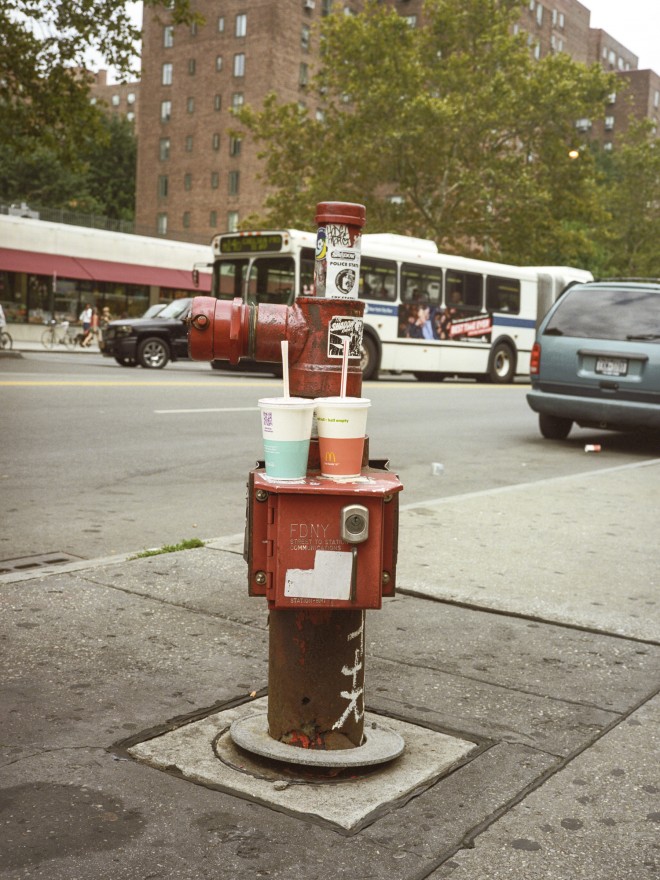
07.01.2017 | Art , Blog , Culture , Fashion | BY: Sarah Roberts
Ben Rayner first made a name for himself photographing artists and musicians for Dazed & Confused and VICE, before transitioning into fashion photography. He has since become a regular fixture of magazines like Wonderland and Vogue. His talents have united him with the likes of Bella Hadid, ASAP Rocky and Alexa Chung, but he has always maintained an interest in producing his own personal work. Ben has published numerous zines and several monographs in the past. His latest project is a book made up of casually shot photographs that realise his aims of producing a photo diary of his day. Aptly named ‘Half Day’, the images have been shot in multiple locations and use an array of different formats, capturing fleeting and intimate snapshots of Ben’s life. Twin spoke to Ben about stealing moments, living in New York and the future.
Tell us about your new book.
The book is a monograph of moments photographed during 2014 and 2015. It’s made up of abstractions, portraits and landscapes. It’s a snapshot of the world as I saw it in those moments. I’m always taking pictures, so after I amass a collection of work I try to put it together in a somewhat coherent way. The book kind of has a fluid narrative of stolen moments in time.
Why did you decide to name the book ‘Half Day’?
I wanted to call the book ‘Half Day’ because it sounded optimistic and is a reminder that you still have half a day left.
A lot of your work has maintained a focus on fashion in the past. How does ‘Half Day’ divert from that?
I shoot a lot of fashion, but have always photographed everything around me. This is my fourth monograph and first hard cover book. I have also published countless zines. To me all my work is a reflection of my view of the world. I think some fashion images could have been dropped into the sequence of this book and still would have made sense. I like to steal moments from people and from the world.
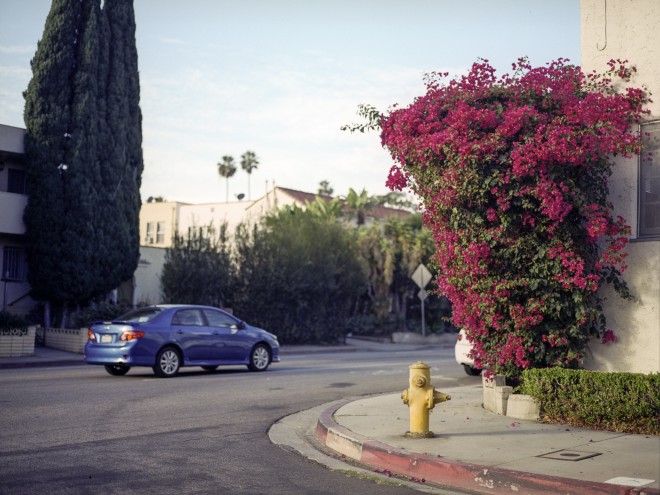
Your photos have been described as ‘stopping time’ as opposed to capturing it. Why do you think that is?
I think sometimes I see things that other people don’t see, like a person’s fleeting expression. My aim is to connect with whoever and whatever I am shooting. I love photographing everyone, from famous models like Alice Dellal and Bella Hadid to actors and chefs.
You made the transition from London to New York. Do you think the change is reflected in your work? If so, how?
I don’t think so really. The images in this book are not very New York heavy. I tend to photograph things more where I don’t live. Although, I have been photographing my personal work in New York a lot more in the last few months.
What’s next for you?
I would like to do some still life photography, and more fashion stories, portraits and personal books. I have lots of ideas. I would also like to do a lot more video work in the future.



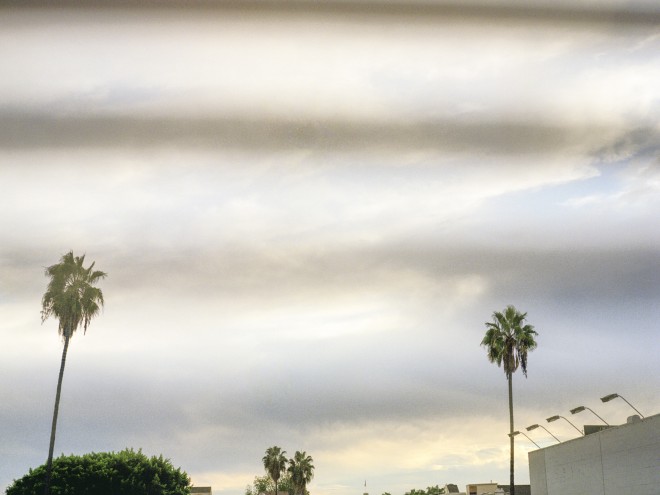
Half Day is available to order now.
Tags: alexa chung, ASAP Rocky, Bella Hadid, Ben Rayner, Contemporary Photography, Fashion, photography

24.11.2016 | Fashion | BY: Sarah Roberts
ELLISS is an exciting new brand that was founded earlier this year by young designer Elliss Solomon. Elliss’ first collection, entitled ‘Unconscious Clothing’, features flattering, contemporary designs, often emblazoned with bold prints, while staying true to the brand’s sustainable ethos. Elliss designs and makes the clothes in the UK to maintain a low carbon footprint, and only uses sustainable organic materials like cotton, hemp and bamboo. We spoke to Elliss about her inspiration behind the brand and the challenges of starting up her own fashion line.
What made you want to become a fashion designer?
I always knew that I wanted to do something creative and decided early that I wanted to study fashion at Central St Martins, which is where I ended up. I used to be very experimental with my outfits. I now dress quite simply and I am more conscious of the small details. That is where the design aesthetic for ELLISS has stemmed from.
Can you tell us a little bit about your vision behind the brand?
I design individual pieces that are beautiful, unusual and easy to wear: clothes that have a story. I am conscious of every step of the process – from how the garment will make you feel, to where it is made and from what materials. The fabrics I use are soft and natural and the garments are made in England to maintain a low carbon footprint. Every item is vegan friendly. The first collection is called ‘unconscious clothing’ which is a play on the idea of the ‘unconscious consumer’. I want the women who buy my clothes to not necessarily be looking for something eco friendly, but to choose a piece because of the design – to unconsciously be conscious.

How do you incorporate political issues into your work?
I am inspired by women who spoke out before others would. This collection incorporates 18th and 19th century portraiture into prints. Each painting or photograph is carefully placed to flatter the female form. The prints are slightly risqué and tongue in cheek. I want the women who wear my clothes to feel confident and empowered.
What materials do you use?
The Jerseys I have chosen for this collection are made from organic cotton, hemp and bamboo. Hemp is the most sustainable fabric. It grows quickly and is so dense it doesn’t allow for weeds. It is also naturally breathable and can be very soft. It hasn’t always had the best reputation but I want to change that. Hemp can be lightweight and delicate!
Which other brands or labels are you inspired by?
I am inspired by small brands that are authentic in their ideas and production. Veja is a footwear brand that has a really interesting supply chain. Although they do use leather, I am still waiting for someone to do something fresh and innovative with sustainable leather alternatives.

How do you choose the names for your designs?
The names come from the different activists that I have referenced in the prints and women in my life who influence me. The Anna body is named after Anna Kingsford, an anti-vivisectionist, vegetarian and women’s rights campaigner who has heavily inspired the prints.
What have been the most challenging aspects of setting up your own clothing line?
There are a lot of challenges but each stage is rewarding when you finally find a solution. I am always looking to my friends and family for feedback. Sourcing everything from fabrics to packaging takes time. When we find a supplier that is great to work with or a fabric that we can continue to use, things become easier. All of our postal packaging is recycled, from the stickers to the mailers. It’s really important to me to waste as little as possible.
What’s next for the brand?
Our online shop has just launched, which is really exciting! The first collection is available to buy now. The next step is working on designs for the second release. I am researching new and inspiring prints at the moment. I can’t wait to see it all come together!
ELLISS is available to shop online at www.elliss.co.uk
Tags: Central Saint Martins, Ellis, Fashion, interview
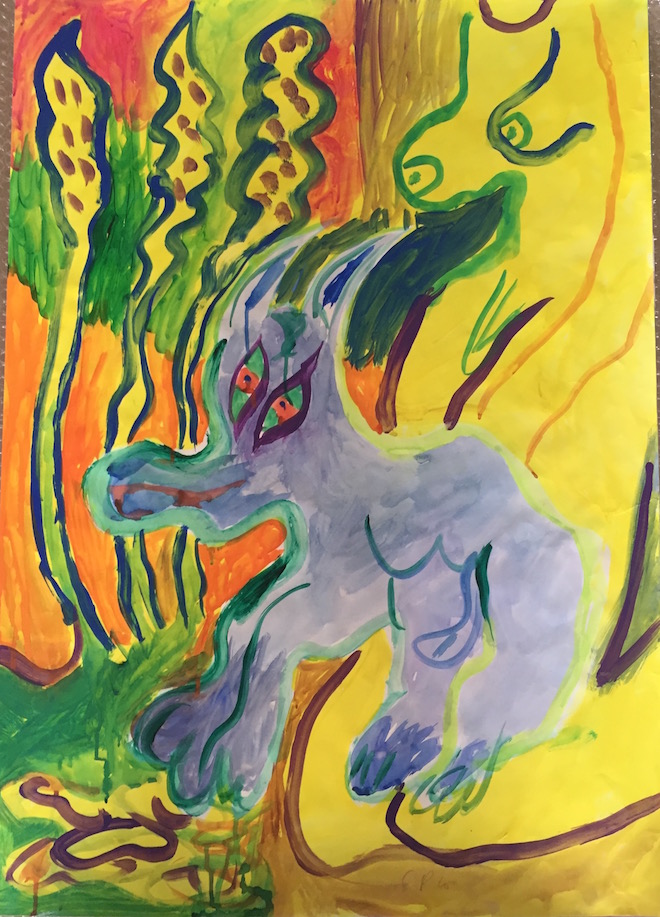
18.11.2016 | Art , Culture | BY: Sarah Roberts
On the 24th of November, American artist Charlie Roberts will be previewing his highly anticipated solo exhibition Juicy at Marlborough Contemporary in London. Roberts borrows the name Juicy from Notorious B.I.G’s 1994 debut single, merging elements of hip-hop subculture with both classical and contemporary artistic influences – from Byzantine iconography, to comic books and Matisse.
Every facet of the exhibition mirrors Roberts’ playful and innovative artistic approach. He reimagines the gallery as a pop-up shop, hanging approximately 200 paper gouaches salon-style throughout the space. In keeping with his ethos, Roberts invites viewers to purchase the art as they see it. The work is accessible and affordable, and as each piece is removed, it is replaced with another, keeping the exhibition in a continuous state of flux.

Contrasting abstract patterned images with fluid female figures, and bright colours with pastel tones, Charlie Roberts juxtaposes every aspect of his work. His reputation as an innovative and exciting artist is ever expanding, and his work continually incorporates characteristics of both popular culture and highbrow art. Earlier in 2016, Roberts collaborated with Danish menswear brand Soulland, creating a successful limited collection of menswear. In his latest display of work at Marlborough Contemporary, Charlie further asserts himself as an inclusive and progressive contemporary artist.
Charlie Roberts: Juicy will be open to the public from the 25th November 2016 until the 7th January 2017 at Marlborough Contemporary
Tags: Charlie Roberts, London exhibition 2016
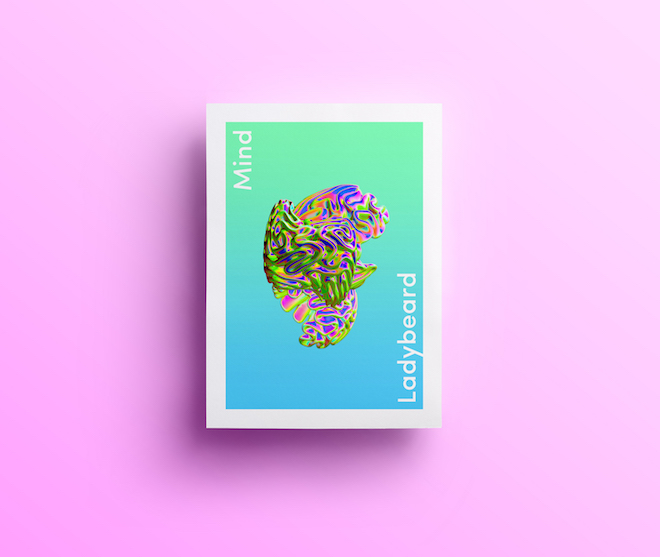
04.10.2016 | Culture | BY: Sarah Roberts
Ladybeard is a relatively new independent magazine, and has recently welcomed its second release, ‘The Mind Issue’. For those who haven’t heard of it, Ladybeard is an annual feminist publication, committed to taking the form and format of traditional glossy magazines and subverting the content. The magazine, which spans over 70 contributors, platforms the voices you don’t hear in traditional women’s magazines, those that deviate from being the “straight, white, cis, able-bodied ideal.”
In ‘The Mind Issue’, which follows on from the bold and provocative ‘Sex Issue’, Ladybeard breaks down the strict dividing line drawn between the mad and the sane. It begins with several first person testimonies of losing one’s mind, before drawing on broad social issues, like exploring the use of MDMA and LSD as effective replacements to traditional prescription drugs. Twin spoke to the Ladybeard team to find out more about the magazine.

Andrew Vladimirov photographed by David Vintiner for ‘The Mind Issue’
How would you describe Ladybeard for those who don’t know it?
We’re a feminist take on the glossy magazine. We theme each issue around a topic that we feel is misrepresented in the mainstream media in general, and women’s magazines in particular, and try to open that topic up to fresh, feminist perspectives. We started with sex and our latest issue is on the mind.
What were your intentions when you first started the magazine?
As a team, we grew up reading women’s magazines and hating the way they made us feel about ourselves. You hear the same voices and see the same ‘woman’ over and over again. The kind of definitions of beauty and sex and gender promoted by those magazines are so damaging. It’s impossible to live up to those standards so the magazine makes you feel like shit, but more than anything, it’s actually really boring reading them because nothing on those pages ever feels true to life. But the magazines themselves are so glossy and beautiful and covetable that you keep buying them, even against your better judgement. With Ladybeard, we wanted to platform the kind of voices you don’t hear in women’s magazines. We felt that if we made a space for many different people to speak honestly about subjects like sex and mental health, but that was also covetable and beautiful, then we might produce a magazine that we would have wanted to read.
What do you think sets Ladybeard apart from other magazines?
Ladybeard is very lucky to be part of a wave of independent women’s magazines that are departing from the glossy mag. What sets us apart, if we had to set ourselves apart, is the way we approach themed issues: we combine very bright, playful visuals with often quite serious content. In our ‘Sex Issue’, for example, we ran a series of very colourful, explicit Peter Stemmler illustrations of different sex positions alongside features on subjects like reclaiming sexual pleasure after rape, and a first person testimony of HIV and sex work. Similarly in the ‘Mind Issue’, we juxtapose really bold visuals alongside content that rethinks the preventative attitude to suicide in the UK, or calls out institutional racism in the mental health system. Our content is often serious, but the idea is to take a theme and celebrate it. We want to celebrate the people doing amazing things to challenge prejudices and inequalities around sex and sexuality, and now mental health.

Illustration by Karan Singh for ‘The Mind Issue’
Can you tell us a bit about Issue 2: ‘The Mind Issue’?
‘The Mind Issue’ looks at our minds: the many facets of mental health; the relationship between how we think and how we live; how we express the self and what it means; how we change each other’s minds, and our own. It’s hard to sum it up! Much like ‘the mind’ as a concept, it is sprawling and hard to pin down, but it’s also colourful, playful and, hopefully, full of surprises.
‘The Mind Issue’ contains a huge amount of content, can you describe the process of putting together an issue?
It’s a lot of hard work! We don’t have a pre-existing structure so we can do what we want in terms of what kind of content we want – one of the perks of being an independent mag! Once we’ve decided on a theme, both the arts and editorial teams brainstorm all the different ways that theme could be approached, particularly through a feminist lens. We do a public call out for submissions and pitches while beginning to reach out to writers, artists, illustrators and people we want to interview. Then arts and editorial join up and begin to fit it all together until it takes its final form in layout. As we all work full-time, it’s a lot of evenings and weekends.
How has the magazine evolved since its first issue, and what can we expect next from the Ladybeard team?
In terms of how it’s evolved – it’s hard to say! The theme dictates each issue – ‘The Mind’ meant we could be more abstract and more exploratory and it ended up being much more explicitly political. We’ll see what happens with the next issue. We’re going to be holding an event later in the year so keep your eyes peeled for that. If all goes to plan, we’ll have another issue out in 2017!
‘The Mind Issue’ is out now. You can purchase a copy at Ladybeardmagazine.co.uk
The Ladybeard team is comprised of: Kitty Drake, Madeleine Dunnigan and Sadhbh O’Sullivan (editors); Scarlet Evans and Bronya Meredith (art direction and design); Tyro Heath and Hannah Abel Hirsch (arts editors)
Tags: feminists, Kitty Drake, Ladybeard, Madeleine Dunnigan, Saidbh O’Sullivan

13.09.2016 | Literature | BY: Sarah Roberts
Having started humbly in 2011 as an A5 DIY zine, in the last five years Mushpit has really come of age, and is in the process of compiling its 9th issue: ‘The Crisis Issue’. Born out of frustration with the rule-bound world of fashion, Mushpit is a playful reaction to glossy magazines, featuring lots of satire, as well as all your favourite tropes of teen magazines, with flow charts and problem pages aplenty.
If you haven’t picked up a copy of Mushpit yet, look no further – we spoke to creators Bertie Brandes and Char Roberts about being vodka lime socialists, unemployment, and what’s in their latest issue, which will be available for you to get your hands on pretty soon.
How would you describe Mushpit to anyone who doesn’t know it?
As useful, useless and stupid hot.
What were your aims when you started Mushpit? What gap do you think you’re filling in the market?
When we started we were very critical of “women’s media” which clearly didn’t cater to us at all. If you liked magazines then you apparently either read Vogue, Dazed, Grazia or W, which felt extremely dated. We also wanted a place to give room to all the amazing writers, photographers, stylists and time-wasters we were hanging around with.

Is there a political agenda you stick to in terms of content or political leaning?
We’re Vodka Lime Socialists and proud.
Where do you draw inspiration from?
Shop signs, fizzy drinks, rival mags and the Ham & High.
Who is your audience?
People with a sense of humour, who are willing to spend money on something they have no idea about – so a lot of media dads. Oh and young women obvvsss!

How has Mushpit evolved since it began in 2011?
It has grown in every sense. It was A5 when we were students and it’s A4 now we’re unemployed.
How do you fund the magazine? Do you have other jobs outside of Mushpit?
Charlotte (hi!) is a stylist and Bertie (hello!) is a writer. We try to do as many morally dubious and anonymous jobs as we can to fund the magazine and it sort of works. We manage to remain proudly ad-free, somehow.
What have been your favourite collaborative moments?
Shooting with Tyrone LeBon was great, and working in Suffolk with Raphy Bliss and Victoria Higgs on the new issue was a real dream shoot. Eloise Parry is an amazing photographer who we love working with, as well as Dexter Lander, who has become a regular contributor. Everything Paul Gorman does for us is phenomenal as well, not excluding him and Caz’s next feature.
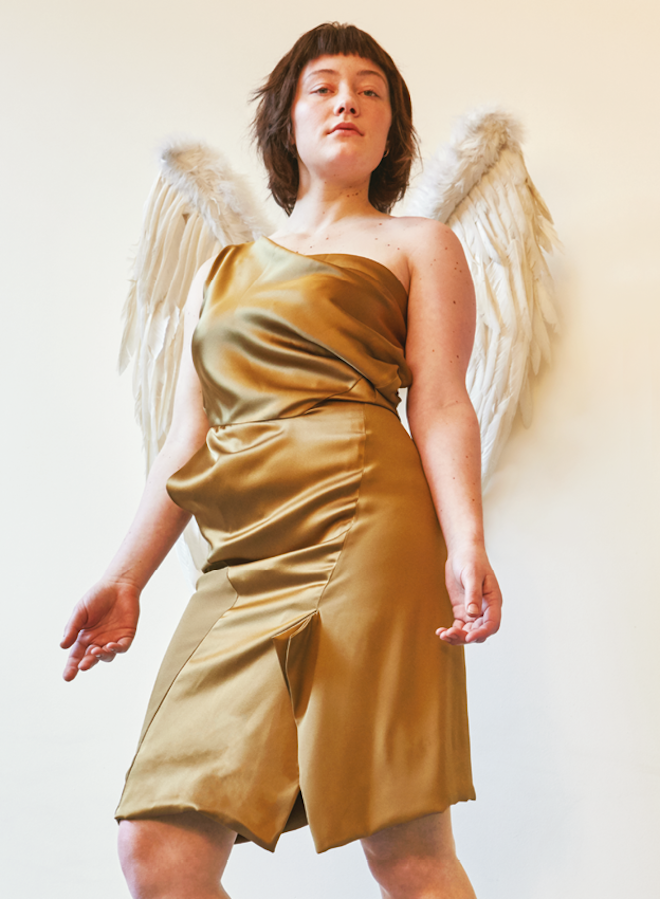
Can you give us any teasers for the next issue?
There’s some great editorial in issue 9; our good friend Martin has interviewed one of the founding editors of Spare Rib and, perhaps a little less high-brow, there’s a dandruff diet page for flaky scalp sufferers.
What kind of impact do you think Mushpit has?
We hope that once you’ve finished the magazine you feel vindicated and victorious… And ready to take on the world! The horrible, horrible world.
‘The Crisis Issue’ is coming in early October to Themushpit.co.uk
All images courtesy of Mushpit Magazine
Tags: Bertie Brandes, Char Roberts, feminists, Mushpit Magazine

28.07.2016 | Art | BY: Sarah Roberts
Photographer Annie Collinge takes pictures that often conjure memories of childhood. Her most recent project, ‘Five Inches of Limbo’, borrows its name from a Margaret Atwood poem about dolls. In the photographs, Annie brings objects to life, pairing dolls she has found in flea markets and on the subway with women found in similar places.
Always shooting on film, instead of using digital photography, Annie’s pictures have a rawness about them, remaining unprocessed and off-key. Without using lighting or effects, her photographs provoke a feeling of otherworldliness, stirred by her delicately chosen subjects, often in costume against a suburban backdrop.
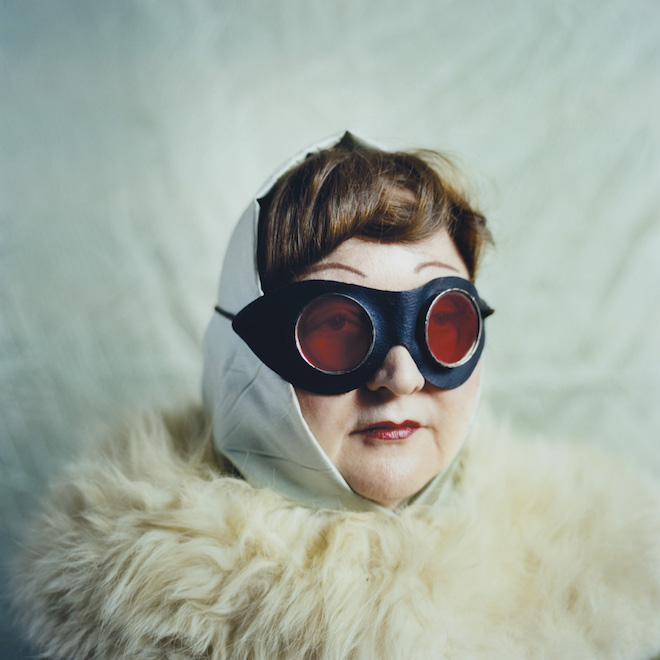
Here, Twin speaks to Annie about the art of inviting strangers back to her apartment, how Instagram has changed the way she works, and her plans for future projects.
Most of your projects use curated concepts instead of found imagery. Where do your ideas come from?
I tend to get ideas from all over the place, from dodgy window displays to car boot sales. I find the process of looking for unusual objects quite meditative, and very often an idea comes to me from an item I’ve found. I like to photograph human interactions with objects, so this usually starts with the object and then I work out how I can include someone.
Why do you tend to use women as subjects in your work?
In the past I tended to photograph a lot of women. I’ve always been interested in the idea of adornment, and women generally, not always, are more adored than men. For my ‘Five Inches of Limbo’ project, I had initially wanted to photograph both men and women, but then I realised that most of the doll’s faces, even if they were male, were made with a female doll face mold, maybe with a moustache drawn on later. I also found approaching strange women less daunting than inviting men back to my apartment to photograph them.
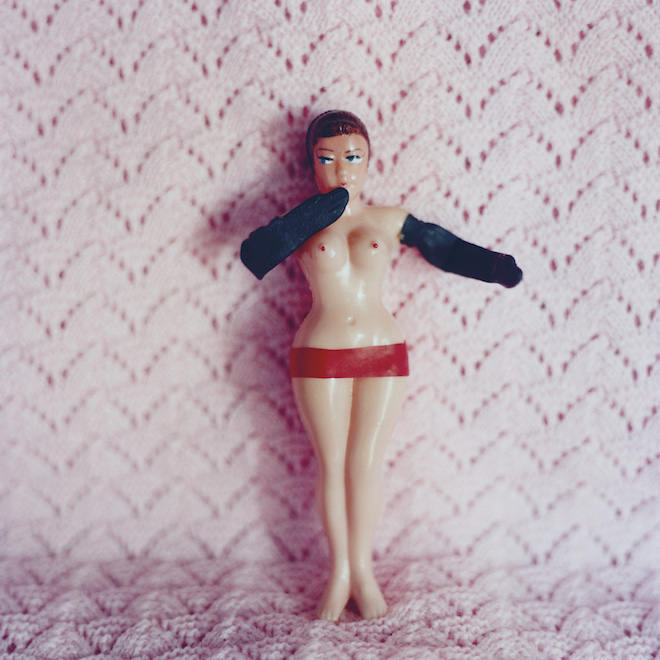

Many of your subjects are strangers. How do you go about approaching them?
Most of my subjects were strangers, apart from the woman with the red goggles on. She is my aunt Yolanda. I’d bought that doll in the Chelsea flea market and one day I was looking at it on my shelf and thought it really looked like Yolanda, which is how the project started. Once I shot her it was easier to approach people as I had an example to show them. I’ve definitely got quite used to approaching strangers now, but I still find it nerve wracking. You learn to brush off the rejections. The most helpful bit of advice I ever heard was from photographer Martin Parr. He said that you must never linger, you must always go straight up to someone. When you linger and they notice you staring at them, it starts to make people paranoid and can make them have a negative reaction to you. I remember sitting in a cafe in the East Village and seeing two girls at the next table, and thinking for too long how I would approach them. After about half an hour of them noticing me giving them strange looks, I went over and was so flustered I think I came across as a complete mad women. They never responded to my email, unsurprisingly.
How has social media impacted the way you work?
Instagram has been great for me, it’s brought my work to a much wider audience and has allowed me to reach out to all kinds of creatives that I may not have known how to contact otherwise. I’ve been working with designers Luke Brooks and James Theseus Buck on a few little projects. I basically just followed them on Instagram and messaged them. We have done a couple of shoots together and are working on a third one now. It’s really nice to work with people who have a similar way of making images and Instagram has allowed us to see how others view the world on day-to-day basis. It doesn’t just show us the polished work we create. It’s nice to see how someone can take an interesting picture of their shoelaces or a weird cloud in the sky without over-thinking the concept. I find that incredibly liberating.

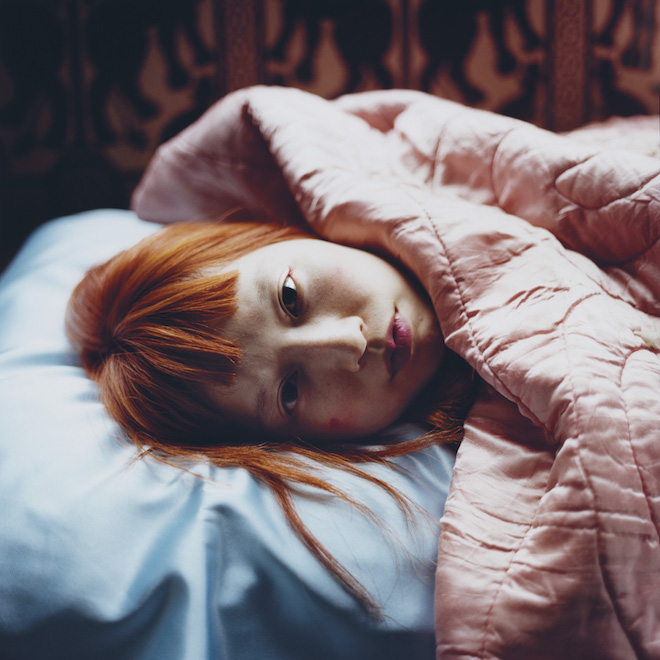
The name of your ‘Five Inches of Limbo’ project was taken from a Margaret Atwood poem. In what other ways did the poem influence your work?
When I read the poem I just knew that I had to include it in my project. It is the most amazing description of a doll I have ever heard, the idea that we carry around these little kind of corpses that never age and only decay. That they are watching us, and just existing, trapped with the expressions they were first manufactured with. It’s amazingly dark and I guess the idea for my project was taking something that is a version of real life, a doll, and turning it back into real life to see how it kind of mutates in the process, so I feel it relates to the poem because of this relationship between what’s real and what’s fake.
Where else do you draw inspiration from?
I think that the books I read as child had a huge influence on the way I make images. I remember how different drawings would make me feel and how I found some things a bit frightening but also a bit thrilling, like The Three Robbers by Tomi Ungerer or In The Night Kitchen by Maurice Sendak. The images were always beautiful and saturated, but at the same time a bit surreal and menacing. I realise now, having a child myself, how important those formative ideas are, and how we learn so much about world from those often strange stories.
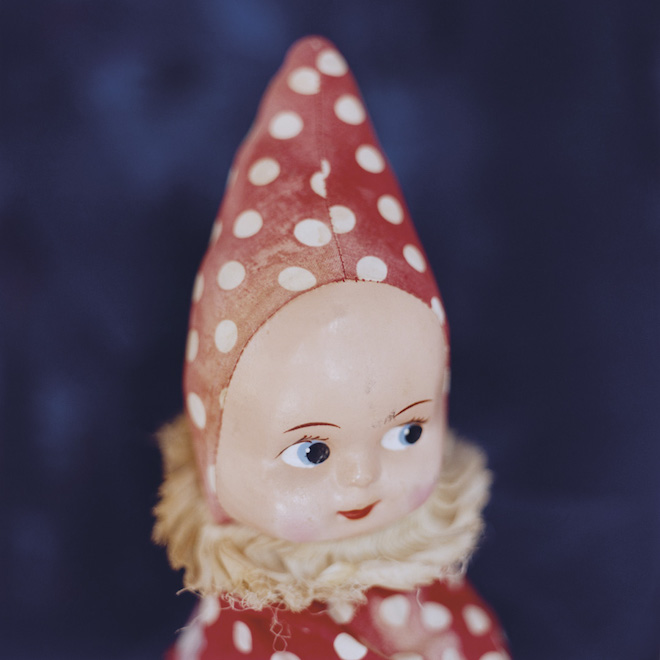

What do you hope people take away from your work?
I would like them to make their own mind up about it, that’s what I love about photography, the ambiguity of it. An image has to have some mystery to it, as that is what leaves a lasting impression.
Do you have any current plans for future projects?
My next big project is going to be a series of constructed images of my family. Not because my family are particularly exciting, but because I feel like I’ve recently been much more aware of how transiently we live, and how our relationships with our families are changing. I’d like to make constructed portraits of my sister, father and mother to preserve them in my own memory. Also because they are the people who I first took pictures of when I first started using a camera. I guess I’ve been photographing strangers a lot and I want to challenge myself to find out how I can see people close to me objectively and still make images interesting to other people.
Collinge.com
Tags: Annie Collinge, James Theseus Buck, Luke Brooks

06.07.2016 | Art | BY: Sarah Roberts
Richie Culver rose to fame in 2010, when he took a magazine cut out of a Jesse Owens photograph and stuck the words ‘Have you ever really loved anyone?’ onto it. Although he had never had any formal training, this first artwork was featured in a group exhibition at the Tate Modern. Richie has since experimented with photography, mixed-media installations and painting, and he has become synonymous with his use of text to accompany his artwork.
This July, a show entitled ‘Things that didn’t really work out – most things’ will combine Jesse’s autobiographical inclination with his text-based medium, providing a dark and humorous look into his life. In Culver’s own words, the exhibition “looks into the realms of sanity, humanity and depravity”. The work began as a book project following a particularly challenging period in Culver’s life and has been developed into a series of wall based works and prints.
The exhibition, which will run from the 28th July until the 2nd of August, will be on display at Protein Studios in Shoreditch. It is Culver’s first London show in three years, and is being exhibited as one of four events put on by Shelter, as part of their Gimme Shelter series. The events are focused around literature, art, music and film and will support Shelter’s work to help people facing homelessness and poor housing. Tickets for each event are allocated via a ballot.
To enter the ballot visit: www.shelter.org.uk/gimmeshelter. Successful entrants will be asked to purchase tickets for their chosen event for £10, with all proceeds going directly to support Shelter’s crucial work.
Richieculver.com
Tags: Gimme Shelter, Jesse Owens, Protein Studios, Richie Culver

27.06.2016 | Fashion | BY: Sarah Roberts
This month, an exciting collaboration between premium denim line Citizens of Humanity and luxury retailer mytheresa.com will become available online. The six-piece collection will launch exclusively on the respective websites and is comprised of limited edition denim outerwear and bottoms.
Heavily inspired by the ’80s and early ’90s heavy metal scene, the designs have drawn a lot of influence from cult band Metallica, introducing subtle details in the designs which hint at the ’90s grunge era. The women’s capsule collection goes against the grain, keeping in mind Metallica’s uniform of denim jackets and distressed jeans. To showcase the line and capture its heavy metal influence, Metallica drummer and founding member Lars Ulrich shot the collection, choosing his wife Jessica Miller to model it.
The collection was designed by the Citizens of Humanity Founder Jerome Dahan and Women’s Creative Director Catherine Ryu. Working in collaboration with mytheresa.com, each piece has been produced in Los Angeles, using Citizens of Humanity’s in-house laundry and manufacturing facilities to produce items unparalleled in quality and fit.
Three new outerwear silhouettes have been introduced in the collection, including the Classic Jacket, an oversized boyfriend fit in a light blue wash, a slimmer fit denim jacket in a vintage blue wash called the Trucker Jacket, and the Trucker Vest, a sleeveless washed black denim vest. Three new trouser styles will also become available, these include a high-rise skinny jean in washed black, a mid-rise straight leg jean in a vintage blue wash, and a mid-rise straight fit in washed black.
Head to citizensofhumanity.com or mytheresa.com to browse the pieces for yourselves, which are now available online.
Tags: Citizens of Humanity, Denim, Metallica, Mytheresa.com

21.06.2016 | Art | BY: Sarah Roberts
Nan Goldin’s ‘The Ballad of Sexual Dependency’ will show at MoMA until the 12th February 2017, giving you ample time to bask in her deeply personal, evocative collection of photographs.
Drawing on her own experiences in Boston, New York and Berlin – mostly during the late 1970s and 1980s – Goldin describes her body of work as ‘The diary I let people read.’ ‘The Ballad of Sexual Dependency’ is comprised of almost 700 photographs and is set against a powerful musical soundtrack, capturing her subjects in raw moments of love and loss, and documenting both herself and her friends as they suffer from drug use, domestic violence and the effects of AIDS.
The collection is aptly named after a song in Bertolt Brecht and Kurt Weill’s ‘The Threepenny Opera’ and features music from many of Goldin’s friends, including Maria Callas and members of The Velvet Underground. The photographs are presented in their original 35mm format, as they were when they were first shown in the bars and clubs of New York City in the 1980s. Since then, Goldin has continued her narrative and added photographs to the collection, but they are still produced as slides, as they were when Goldin had no access to a dark room and was unable to afford to have her photographs made into prints.
‘The Ballad of Sexual Dependency’ is also available in the form of a book, which was reissued in 2012, recognising the persistent relevance of Goldin’s subject matter. The book can be bought online, or is available at MoMA.
Moma.org
Tags: MOMA, nan goldin, The Ballad Of Sexual Dependency, The Velvet Underground

16.03.2016 | Fashion | BY: Sarah Roberts
Dr Martens have headed some successful collaborative projects lately, like their alliance with Supreme for an Autumn Winter 2015 special collection. This Spring, they will release another collaborative effort, in the form of a low-cut take on the brand’s high-top classic.
Towards the end of March, Dr Martens will welcome their limited edition shoe with cult Parisian fashion store colette. The design incorporates both classic design and modernity, resulting in a fresh unisex style. The design is a special take on their Dr Martens classic 1461 3-Eye boot. The simple shoe is a low-top model, made from soft black leather with an all-over glossy polka dot print and bursts of colour added with the blue dipped lace tips, blue stitching and blue detail at the back of the shoe.
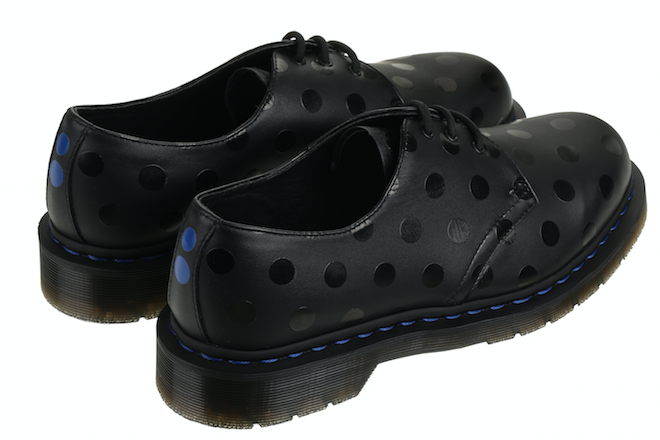
The Dr Martens X colette collaboration was released exclusively in the Parisan colette store on the 27th February, and is due to become available in the UK on the 26th March. The shoe has already sold out on the colette website and is expected to do the same in the UK. The special edition shoes will be sold at £115 from selected Dr Martens outlets such as The Goodhood Store, End. and Hervia.
drmartens.com
Tags: colette, Dr Martens
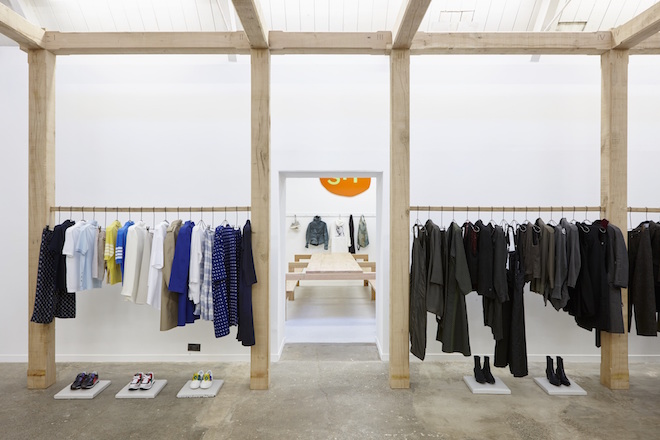
18.02.2016 | Fashion | BY: Sarah Roberts
East London clothing store Hostem has moved into a temporary space in Nichol Street for the spring, with the interior inspired by the sculptures of artist Oscar Tuazon.
Located just a minute’s walk away from their original Shoreditch location in Redchurch Street, the gallery interior at 28 Old Nichol Street has been conceived and built entirely in-house. It is an open-plan design, featuring original Chandigarth Pierre Jeanneret furniture and artwork by Lucien Smith, Kika Karadi and Graham Collins. A freestanding timber frame structure showcases men and women’s garments from the likes of Lanvin, Thom Browne, Loewe, Dries Van Noten, Comme des Garcons, Visvim, Yohji Yamamoto and Geoffrey B. Small.
The menswear boutique, which launched in 2010, has earned a World Architect Festival Award for the design of its Redchurch Street store, which over the course of five years has been expanded by five storeys. The temporary site will be used while the Redchurch Street store undergoes further expansion.
To celebrate the opening of their new space, Hostem are running their first ever Instagram competition, with a prize of £5,000. On visiting the Nichol Street store, entrants are invited to take a picture of the new space and to leave their name, email address and Instagram name in the guestbook. An Instagram user will be chosen from those who upload the picture accompanied with the hashtag #HostemSpringStoreE27HR. The competition closing date is the 9th March 2016.
hostem.co.uk
Tags: Comme des Garçons, Dries Van Noten, Graham Collins, Hostem, Kika Karadi, Lanvin, Loewe, Lucien Smith, Thom Browne, Visvim, Yohji Yamamoto
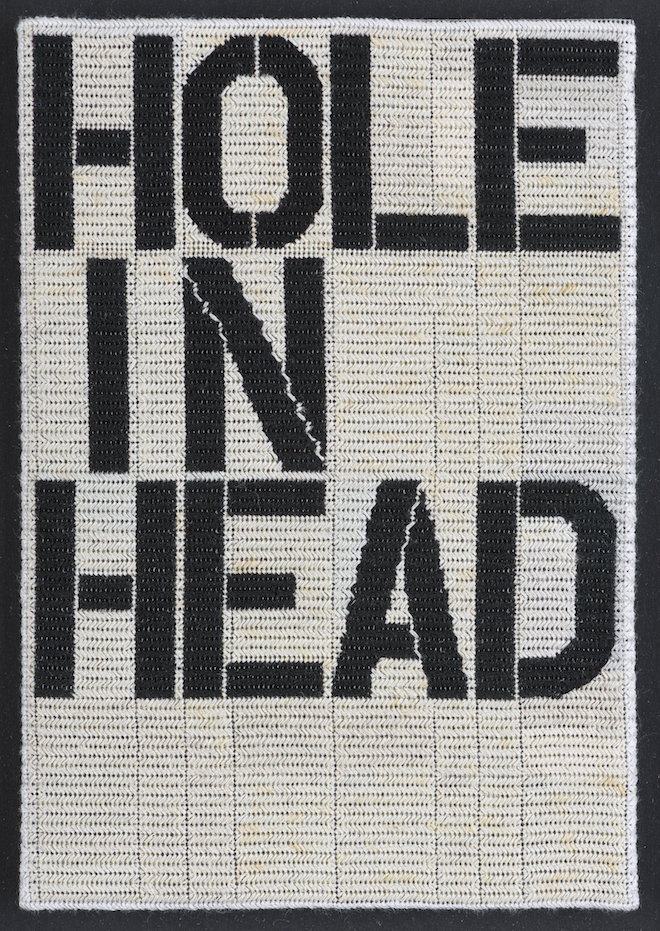
03.02.2016 | Art | BY: Sarah Roberts
Narelle Jubelin was born in Sydney Australia in 1960, and has lived and worked in Madrid for the last 20 years. She has been exhibited widely across the globe, making a name for herself with her miniature petit point interpretations of photographs and paintings. Her unique work engages with the translation of visual culture across countries, with a nod towards the tropes of international Modernism. This week she launches her second solo show with Marlborough Contemporary in London: Flamenco Primitivo, an exhibition influenced by both her relationship with Spain and cultural and historical issues surrounding her native Australia.
Flamenco Primitivo takes its title from the opening ‘cante’ performed in Madrid by contemporary Flamenco singer Niño de Elche. The collection of new works by Narelle Jubelin will explore the way in which objects of cultural significance travel through the world, with each display adding to their value.
Jubelin’s petit point renditions of influential, regional Modernist works will include pieces by Anni Albers, Hannah Höch, Ree Morton and Pablo Picasso. As well as these artworks, the exhibition will also feature five bronze works cast from packaging buffers, originally designed for the purpose of secure travel over long distances. These pieces will symbolize the geography of her method. Additional video footage marks Jubelin’s own journey and experience, documenting ‘unrepeatable’ moments using various pieces of found and assembled film. Each aspect of Flamenco Primitivo comes together to reflect on how individuals interpret and record histories of creative difference, whilst also gaging how these experiences translate between cultures.
The exhibition will be shown at Marlborough Contemporary from Friday 5th February, until 12th March 2016.
marlboroughlondon.com
Main image: Narelle Jubelin, As yet untitled (Christopher Wool, 1992), 2014, cotton on silk petit point, Courtesy the artist and Marlborough Contemporary, London.
Tags: Anni Albers, Hannah Höch, Nacelle Jubelin, Pablo Picasso, Ree Morton

26.01.2016 | Literature | BY: Sarah Roberts
To welcome 2016, Taschen books are launching a sale that will run from the 28th to the 31st of January. Taschen’s South London store – situated in Duke of York Square – will offer discounts of between 50-75% on displayed and slightly damaged titles, which will also be extended to their website www.taschen.com.
Originally known as Taschen Comics, the publishing house was established in 1980 by Benedikt Taschen to publish his extensive comic book collection. It has since become a force in making lesser-known art available to mainstream bookstores and in bringing subversive art into broader public view. Taschen has always embraced potentially controversial material alongside books that focus on subjects like art photography, comics, painting, fashion, film and architecture. Their reputation of producing more daring titles on fetishistic imagery, queer art, historical erotica and pornography has set them apart from traditional competitors, making Taschen the first stop for lovers of print, art, anthropology… and aphrodisia.
In its 35-year history, Taschen has garnered a global following and made headlines several times. It has produced the world’s most popular art book series, the introductory Basic Art Series, and has broken records with Helmut Newton’s SUMO – the most expensive book published in the 20th Century. Last year, Taschen introduced Art and Collectors Editions with models Gisele Bündchen and Naomi Campbell, photographer Bettina Rheims and music icon David Bowie. Join Taschen on the 28th of January as they celebrate many new, bold ventures for 2016, and indulge your artistic, or erotic, needs.
Tags: Books, David Bowie, Helmut Newton, Naomi Campbell, Taschen

08.01.2016 | Art | BY: Sarah Roberts
Annie Leibovitz is widely considered to be one of the world’s best portrait photographers. Her book Women, which was first published in 1999, celebrates an array of women, from Supreme Court Justices and Vegas showgirls to coalminers and farmers. In 2016, the project is set to continue in the form of a travelling exhibition, making its debut in January at the Wapping Hydraulic Power Station in London.
Over twelve months, Annie Leibovitz’s new portraits will appear in ten cities; London, Tokyo, San Francisco, Singapore, Hong Kong, Mexico City, Istanbul, Frankfurt, New York and Zurich. The new portraits will display the changes in women’s roles in contrast with those 15 years ago. Alongside Leibovitz’s new work, visitors will be able to view work from the original series and other photographs taken since.
Speaking at a press conference at Somerset House, Leibovitz describes how Women ‘is an unending project, it goes on and on.’ The original project is Annie Leibovitz’s most popular body of work and was a collaborative series with her partner Susan Sontag, who accompanied the subject matter with an essay. Sontag passed away in 2004, but her influence had a lasting effect on Leibovitz’s photography, with Sontag encouraging her to become more intimate with her photographs.
The original book features 100 portraits of women, including public figures like Hillary Rodham Clinton and Gloria Steinhem, and Leibovitz has promised 20 additional images to the project in 2016. At present, only one new photograph from the series has been released, of Leibovitz and her daughters Sarah, Susan and Samuelle. However, Leibovitz has confirmed that new portraits from the series will include Venus and Serena Williams, Amy Schumer and her sister Kim Caramele, Misty Copeland, and Caitlyn Jenner.
WOMEN: New Portraits has been commissioned by UBS and will be presented to the public for the first time on the 16th January 2016 at the Wapping Hydraulic Power Station in London. Admission is free.
ubs.com
Tags: annie leibovitz, Art, london, photography, Women

19.12.2015 | Art | BY: Sarah Roberts
From 13th March 2016, Hauser Wirth and Schimmel, a gallery in the heart of the downtown LA art district, will host ‘Revolution in the Making: Abstract Sculpture by Women, 1947 – 2016’, an exhibition featuring almost 100 artworks by 34 female artists. Spanning seven decades, the exhibition aims to reflect on women’s artistic progression in the field of sculpture.
The display will be partly overseen by Paul Schimmel, the former chief curator at the Museum of Contemporary Art. He has noted that the exhibition is modeled on gallery founder Ursula Hauser’s private collection, which included several pieces by prominent female artists.
The exhibition will explore how integral elements of contemporary art have been pioneered by female artists since the post-world war II era, who in seeking to form their own artistic narrative, expanded and redefined sculpture.
Moving chronologically, the exhibition takes off directly after the Second World War, when sculptors like the legendary French artist Louise Bourgeois and New York artist Louise Nevelson combined feminism and surrealism to create large-scale sculptures and installation art. Moving forward into the 1960s and 70s, works by Post-Minimalist artists including German Eva Hesse and the iconic Yayoi Kusama illustrate how conventional uses of materials changed at this time, with tactility incorporated into sculpture to convey the artists’ presence.
The exhibition continues with artists emerging from the Post-Modernist era and expanding further into the realm of installation art, using videos and being more expansive in their use of space. Concluding with work by a new generation of sculptors, much of which has been commissioned especially for the exhibition, visitors are able to see how artists have built upon the legacy of previous sculptors, while incorporating new uses of colour and materials into their work.
The exhibition will run until 4th September, 2016.
hauserwirthschimmel.com
Tags: Art, Hauser Wirth and Schimmel, LA, sculpture, Women
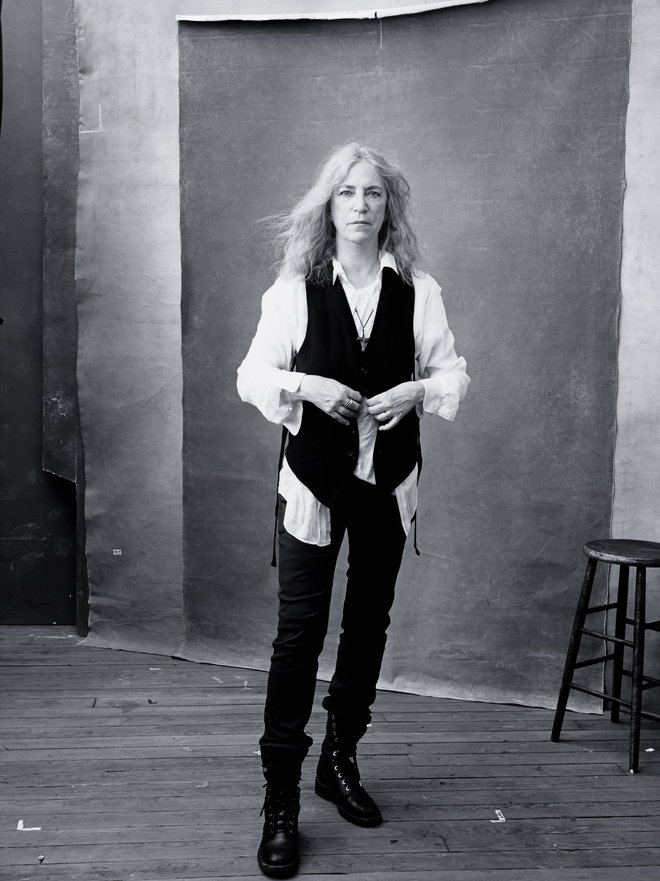
10.12.2015 | Art , Thoughts | BY: Sarah Roberts
The Pirelli 2016 Calendar has been met with contrasting reviews. Most people have been singing its feminist praises; in a markedly new direction compared with previous years, the calendar has welcomed a diverse array of successful women, and offers varied and mostly clothed images of female bodies, diverting from its usual display of artful nudity. Others have noted that while the calendar celebrates female empowerment, it also limits the sexual attractiveness and femininity of the women on its pages. It suggests that women can be either successful or beautiful, but not both.
To interpret the Pirelli 2016 calendar in this binary way would overlook the point of the pictures, in Leibovitz’s words they are to show the women exactly as they are. The calendar shows us that our bodies can be used in different ways; to represent power and strength, like the striking shot of Serena Williams’ rippling back muscles. Or as a comedic device, like the photo of Amy Schumer topless and surprised, suggesting that she didn’t get the ‘clothes on’ memo this year. These are ways that men’s bodies have been presented for a long time in the media. More than showing that flaws or quirks can be beautiful and sexy, these pictures invite us to look past the sexualisation of women’s bodies and to start noticing the other things a body can do, like be strong, powerful, suited and booted.
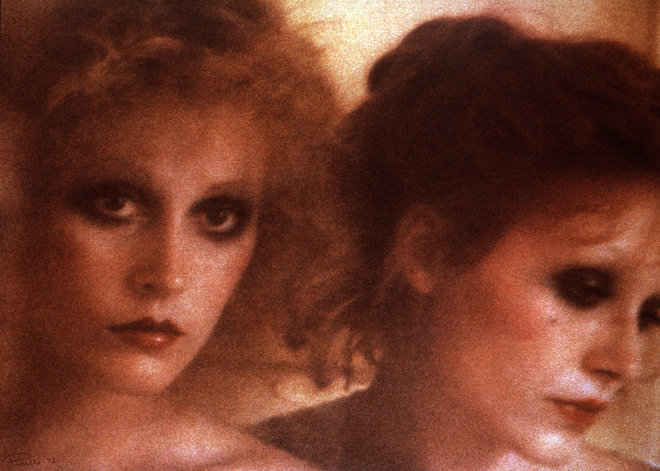
February, 1972, Sarah Moon
The calendar has gone viral on social media, and no matter how it is interpreted, having an iconic publication like the Pirelli calendar joining and extending the conversation about female representation can only be a good thing. Just a year ago, Pirelli’s calendar was a spread of high profile supermodels in various states of undress. The calendar may be just one small step for womankind, but it is one big step for Pirelli and towards the cultural shift we are all yearning for.
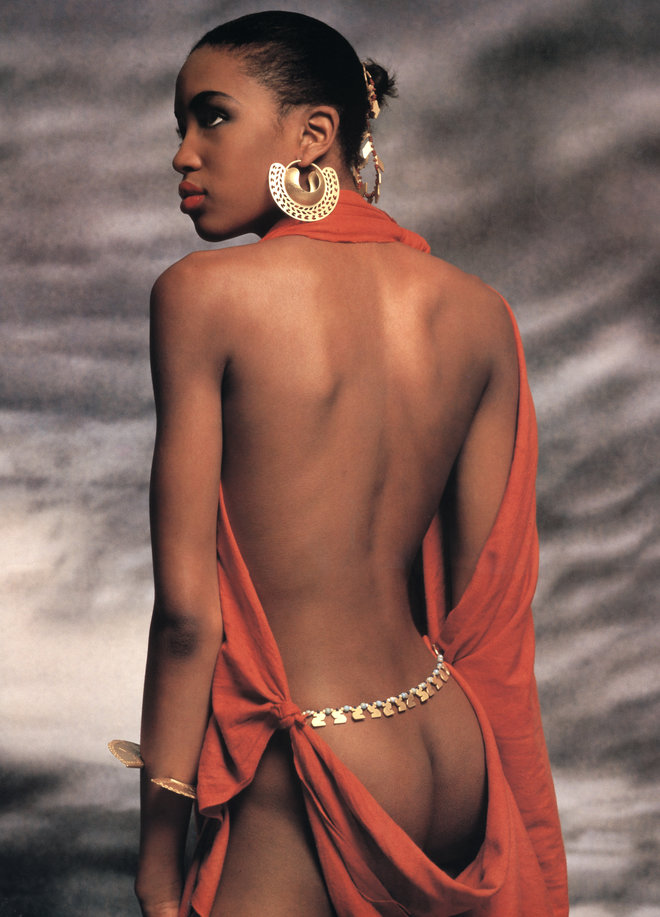
December, 1987, Terence Donovan
pirellicalendar.pirelli.com
Tags: amy schumer, annie leibovitz, Art, Patti Smith, photography, Pirelli, serena williams










































 Twitter
Twitter
 Tumblr
Tumblr
 YouTube
YouTube
 Facebook
Facebook
 Instagram
Instagram
